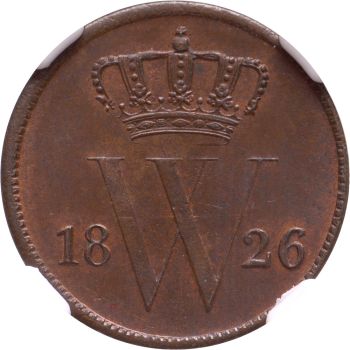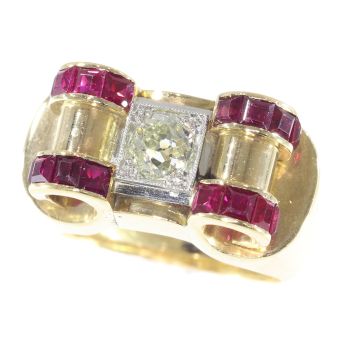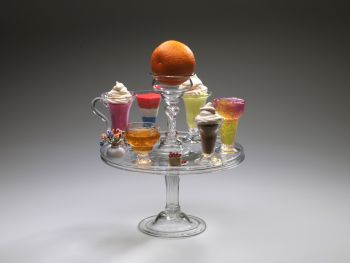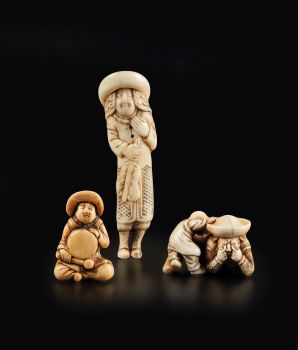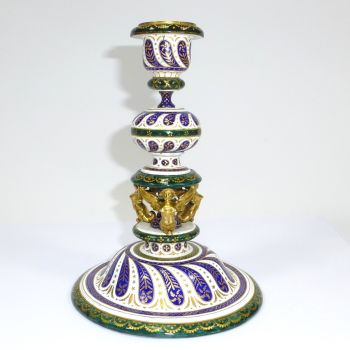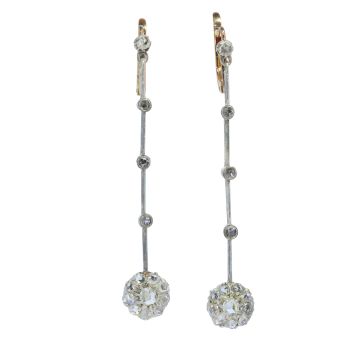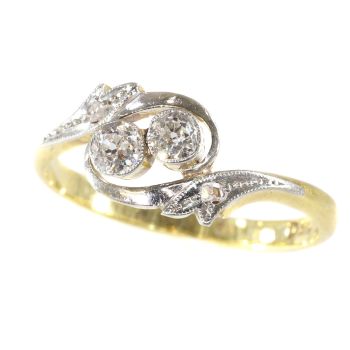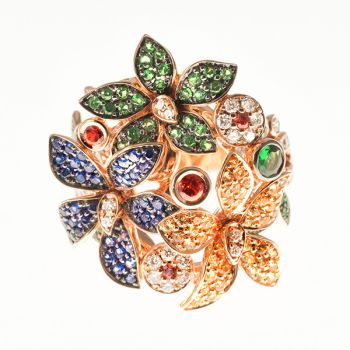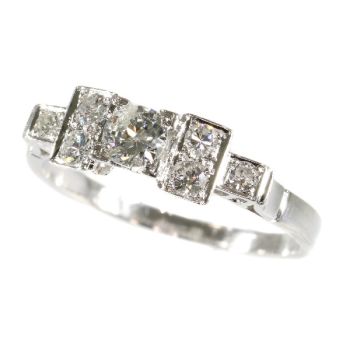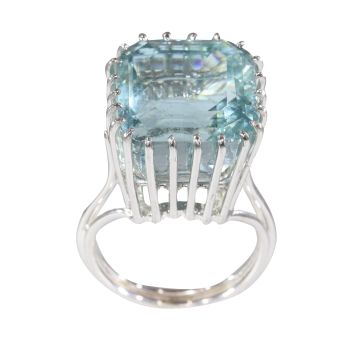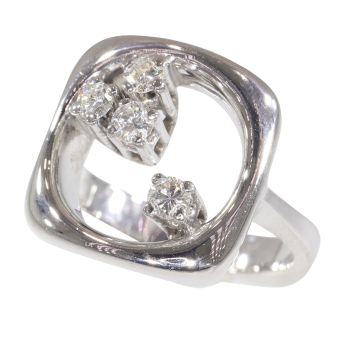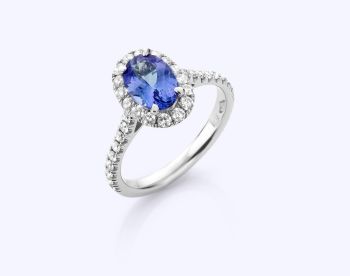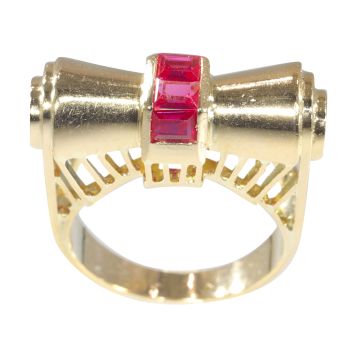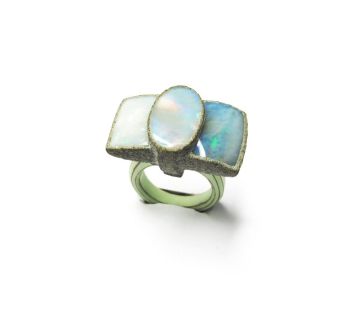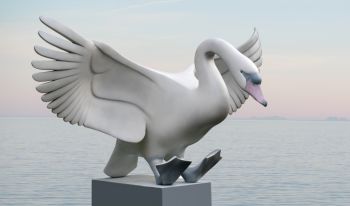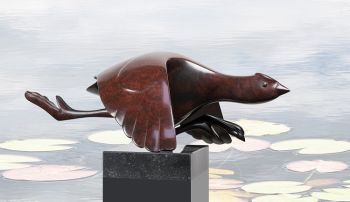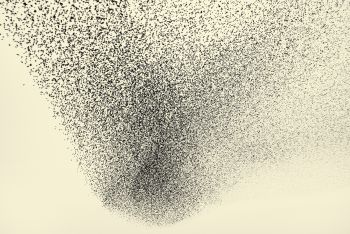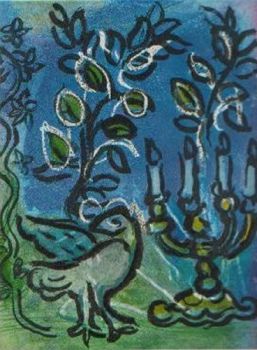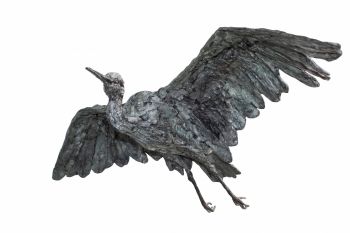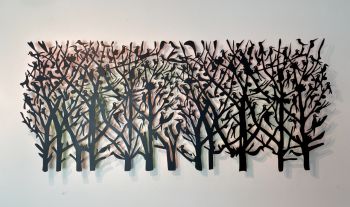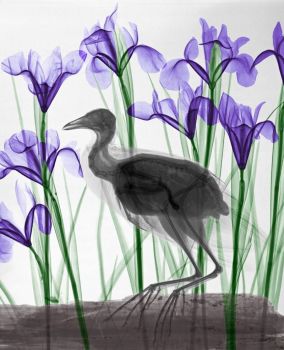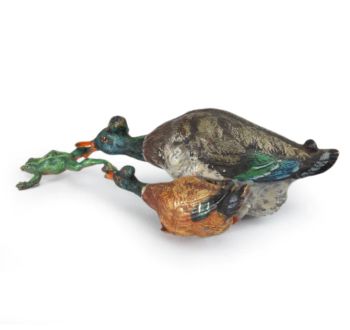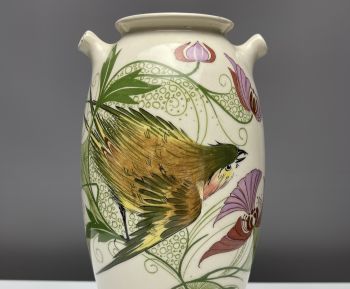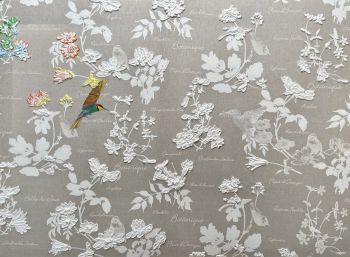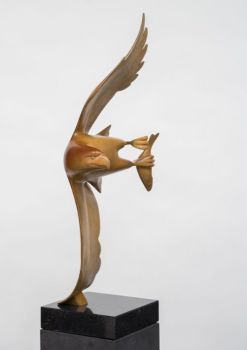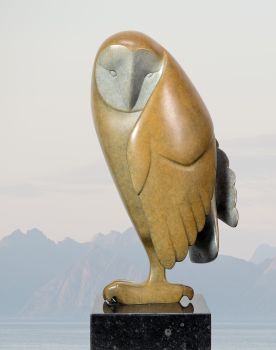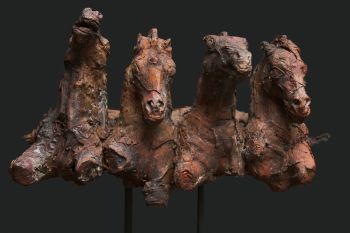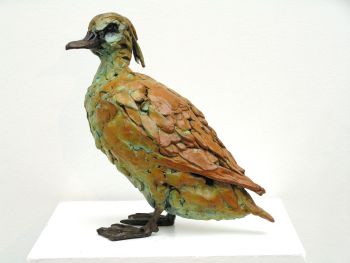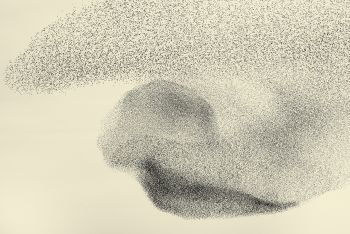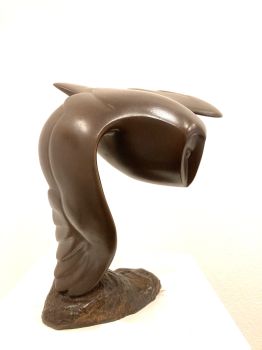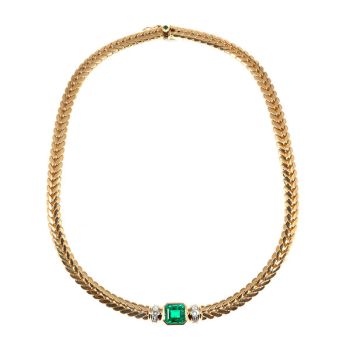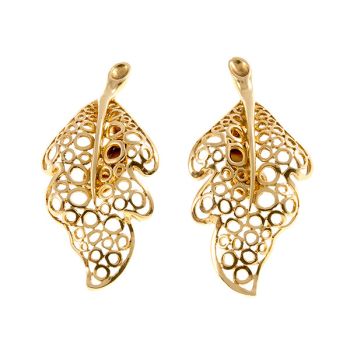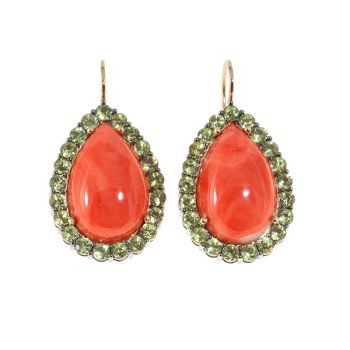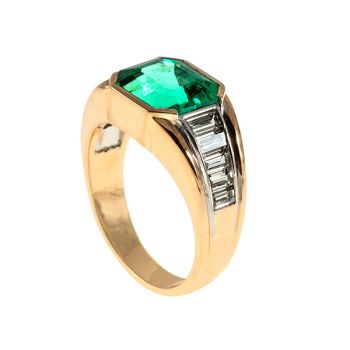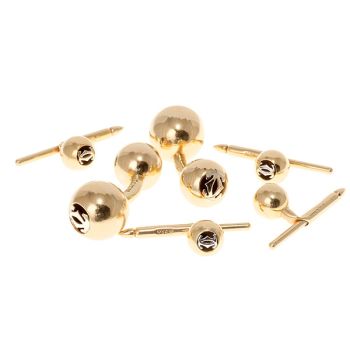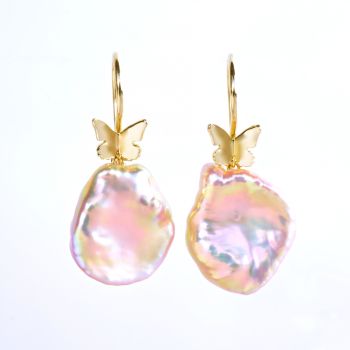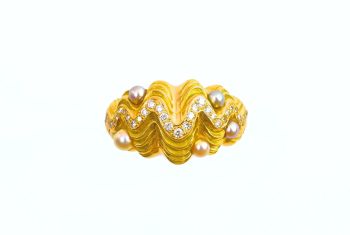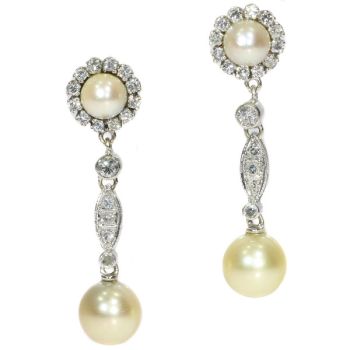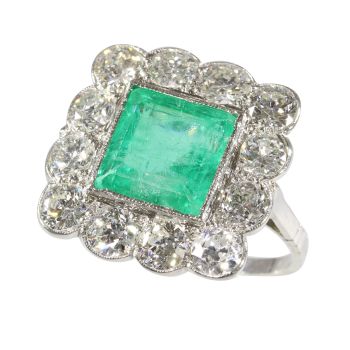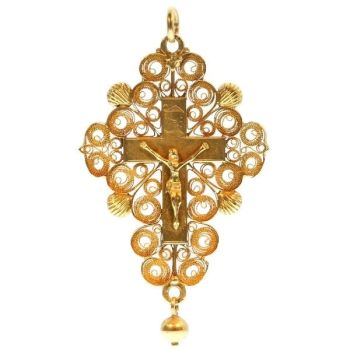Objet d'art - Objet victorien antique français représentant la fable d'Esope 1860
Artiste Inconnu
Adin Fine Antique Jewellery
- Sur l'oeuvre d'art
This French 18K yellow gold and silver Victorian object d'art is a depiction of substance in many ways. With its wide gold outlined wings, crest and tail, the silver downy stork triumphs audaciously with an amphora crafted from a grand natural saltwaterbaroque pearl with a gold rim on top and a seed pearl in the gold bottom. Bringing the jar with its gold claws to its gold beak and looking right at you with its cabochon onyx and turquoise eyes, this piece of decorative art is claw-set on a gold shank,which follows the shape of the bird and makes it possible to wear it as a ring. Now, who should be the fox that deserves what's coming her way in your own fable by Jean de La Fontaine?
The inspiration for this jewellery piece lays more likely in the translation of Aesop's "The fox and the stork" by Jean de La Fontaine. In the 17th century, he was the most famous French fabulist and an example for writers throughout Europe.
We hope you will enjoy looking and learning about this piece as much as we did!
Master goldsmith: Although we couldn't find any master mark in the stork, it is because of the level of craftmanship that we think that this could have been madeby the house Froment-Meurice.
Antique jewelry object group: object d'art (possible to wear as ring)
Condition: excellent condition
- (more info on our condition scale)
Country of origin: France
Period: ca. 1850-1870
- (events and facts in 1860)
Style: Victorian - Victorian decorative arts refers to the style of decorative arts during the Victorian era. The Victorian era is known for its eclectic revival and interpretation of historic styles and the introduction of cross-cultural influences from themiddle east and Asia in furniture, fittings, and Interior decoration. Victorian design is widely viewed as having indulged in a regrettable excess of ornament. The Arts and Crafts movement, the aesthetic movement, Anglo-Japanese style, and Art Nouveaustyle have their beginnings in the late Victorian era.
- See also: Victorianor more info on styles
Source of inspiration: Aesop's fable: "The fox and the stork".
Aesop's fable: "The Fox and the Stork":
At one time the Fox and the Stork were on visiting terms and seemed very good friends. So the Fox invited the Stork to dinner,and for a joke put nothing before her but some soup in a very shallow dish. This the Fox could easily lap up, but the Stork could only wet the end of her long bill in it, and left the meal as hungry as when she began.
"I am sorry," said the Fox, "the soup is not to your liking." "Pray do not apologize," said the Stork. "I hope you will return this visit, and come and dine with me soon."
So a day was appointed when the Fox should visit the Stork; but when they were seated at table all that was for their dinner was contained in avery long-necked jar with a narrow mouth, in which the Fox could not insert his snout, so all he could manage to do was to lick the outside of the jar.
"I will not apologize for the dinner," said the Stork: "One bad turn deserves another."
More background information on Aesop - Aesop (c. 620–564 BC) was a fabulist or story teller credited with a number of fables now collectively known as Aesop'sFables. Although his existence remains uncertain and (if they ever existed) no writings by him survive, numerous tales credited to him were gatheredacross the centuries and in many languages in a storytelling tradition that continues to this day. In many of the tales, animals speak and have human characteristics. (from: Wikipedia)
Theme: The stork holding and eating from the long-necked jar with narrow mouth
Material: 18k yellow gold and silver.
- (more info on precious metals)
Technique: The stork is skillfully modelled and engraved in silver that has been richly and yet tastefully embellished with gold accents. See the stork's crest, beak, claws, tale, and the outlines of the wings.
Extra information: It is almost certain that this piece of art started as a decoration for another, even more, impressive piece. The way the ring to hold it, looks rather simple on first sight but we fully understand and supportthe way of thinking of the goldsmith who made it. It respects the original piece of art by a master goldsmith and does not alter it in any way.
That is why we decided to offer it in the same manner as we found it.
Precious stones: One big baroque pearl used as the jar that the stork is holding, one seed pearl at the outside of the bottom of the "jar".Two little cabochon cut stones, one onyx and one turquoise
- (more info on precious stones)
Birthstones: Pearl is the birthstone (or month stone) for June, turquoise for December and onyx for July.
- (more info on birthstones)
Hallmarks: The ring is hallmarked with the French control mark for 18K gold representing an eagle's head that was in use in France from about 1838. We couldn't find any hallmarks on the stork.
- (more info on hallmarks)
Dimensions: 3.72 cm (1.46 inch)
Weight: 17.30 gram (11.12 dwt)
Ring size Continental: 54 & 17¼ , Size US 6¾ , Size UK: N
Resizing: Free resizing (only for extreme resizing we have to charge).
- (more info on ring sizes)
Reference Nº: 09357-4261
Copyright photography: Adin, fine antique jewelry
- Sur l'artiste
Il peut arriver qu'un artiste ou un créateur soit inconnu.
Certaines œuvres ne doivent pas être déterminées par qui elles sont faites ou elles sont faites par (un groupe d') artisans. Les exemples sont des statues de l'Antiquité, des meubles, des miroirs ou des signatures qui ne sont pas claires ou lisibles, mais aussi certaines œuvres ne sont pas signées du tout.
Vous pouvez également trouver la description suivante :
•"Attribué à …." A leur avis probablement une oeuvre de l'artiste, au moins en partie
•« Atelier de …. ou « Atelier de » À leur avis, une œuvre exécutée dans l'atelier ou l'atelier de l'artiste, éventuellement sous sa direction
•« Cercle de… ». A leur avis une oeuvre de la période de l'artiste témoignant de son influence, étroitement associée à l'artiste mais pas forcément son élève
•« Style de … ». ou "Suiveur de ...." Selon eux, une œuvre exécutée dans le style de l'artiste mais pas nécessairement par un élève ; peut être contemporain ou presque contemporain
•« Manière de… ». A leur avis une oeuvre dans le style de l'artiste mais d'une date plus tardive
•"Après …." A leur avis une copie (quelle qu'en soit la date) d'une oeuvre de l'artiste
•« Signé… », « Daté… ». ou « Inscrit » À leur avis, l'œuvre a été signée/datée/inscrite par l'artiste. L'ajout d'un point d'interrogation indique un élément de doute
• "Avec signature ….", "Avec date ….", "Avec inscription …." ou "Porte signature/date/inscription" à leur avis la signature/date/inscription a été ajoutée par quelqu'un d'autre que l'artiste
Êtes-vous intéressé par l'achat de cette oeuvre?
Artwork details
Related artworks
Artiste Inconnu
UN MODÈLE JAPONAIS D'UN NORIMONO, UN PALANQUIN1650 - 1700
Prix sur demandeZebregs & Röell - Fine Art - Antiques
Artiste Inconnu
Néerlandais en miniature18th century
Prix sur demandeZebregs & Röell - Fine Art - Antiques
1 - 4 / 12- 1 - 4 / 24
- 1 - 4 / 24
- 1 - 4 / 24
- 1 - 4 / 24
- 1 - 4 / 12








